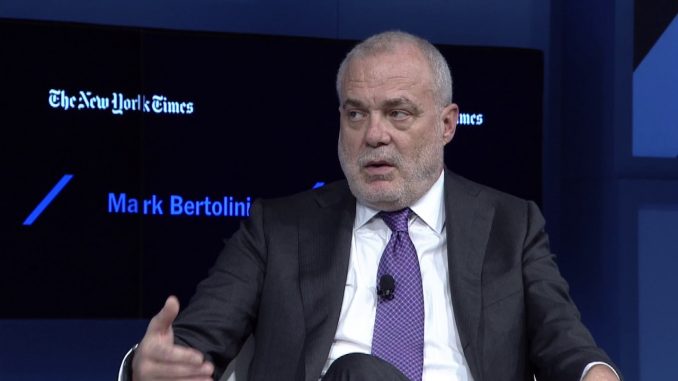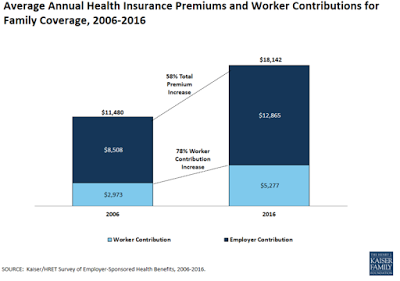
At a recent post-election DealBook Conference sponsored by the New York Times, host Andrew Ross Sorkin interviewed Aetna’s Chairman and CEO, Mark Bertolini, discussing the subject of the future of health care in America. In the interview, the two gentlemen discuss the future of Obamacare, a subject that is particularly pertinent given that Donald Trump has pledged to end what has proven to be a somewhat less than successful attempt at providing universal health care for Americans.
Before we go any further, let’s look at what happened back in August 2016. Aetna announced the following:
“Following a thorough business review and in light of a second-quarter pretax loss of $200 million and total pretax losses of more than $430 million since January 2014 in our individual products, we have decided to reduce our individual public exchange presence in 2017, which will limit our financial exposure moving forward. More than 40 payers of various sizes have similarly chosen to stop selling plans in one or more rating areas in the individual public exchanges over the 2015 and 2016 plan years, collectively exiting hundreds of rating areas in more than 30 states. As a strong supporter of public exchanges as a means to meet the needs of the uninsured, we regret having to make this decision.
Providing affordable, high-quality health care options to consumers is not possible without a balanced risk pool. Fifty-five percent of our individual on-exchange membership is new in 2016, and in the second quarter we saw individuals in need of high-cost care represent an even larger share of our on-exchange population. This population dynamic, coupled with the current inadequate risk adjustment mechanism, results in substantial upward pressure on premiums and creates significant sustainability concerns.
The vast majority of payers have experienced continued financial stress within their individual public exchange business due to these forces, which also are reported to have contributed to the failure of 16 out of 23 co-ops. We are encouraged by a recent announcement that the U.S. Department of Health and Human Services will explore new options to modify the risk adjustment program, and remain hopeful that we can work with policymakers from both parties on a sustainable public exchange model that meets the needs of the uninsured.
We are committed to a health care marketplace that gives every American the opportunity to access affordable, high-quality care. We will continue to evaluate our participation in individual public exchanges while gaining additional insight from the counties where we will maintain our presence, and may expand our footprint in the future should there be meaningful exchange-related policy improvements.
Aetna will reduce its individual public exchange participation from 778 to 242 counties for the 2017 plan year, maintaining an on-exchange presence in Delaware, Iowa, Nebraska and Virginia. The company will continue to offer an off-exchange individual product option for 2017 to consumers in the vast majority of counties where it offered individual public exchange products in 2016.” (my bold)
Now, let’s go to the interview. When asked what will happen to Obamacare now that Donald Trump is president-elect, Mr. Bertolini states the following:
“So I think there will be a repeal first, and I think that the repeal will be at a minimum in name because what’s going to happen over the next year is, um, we have people signed up so we have to honour that commitment through 2017. We’ll have to act quickly to get something in place for 2018. So, I think things like guaranteed issue, um, no pre-existing conditions, I think things like 26-year olds on their parents’ policy, I think the expansion of Medicaid are all very important programs that we need to continue. So, how do those get passed going forward? And then we have this population that uses the exchange, which are people between 45 and 65 who have chronic illness and can’t afford their own insurance outside of the exchange and need to be subsidized . So, I think on the first population, it’s easy to make that happen, we can keep those program changes in place and, as a matter of fact, they weren’t part of the ACA in a lot of ways anyway.”
When asked what does this all mean for Aetna’s business strategy, here’s what he had to say:
“Eighty-one percent of Americans hate their health insurance. They hate the health care system. We have too many uninsured. It’s not affordable even for people making six figures so it still has to be fixed. We still need to insure everybody. The approaches will be different from a policy standpoint and a fading standpoint but we still need to have a product that’s affordable, more personalized, simpler to use, that people can buy like they buy everything else today.”
Now, let’s look at Aetna’s bottom line. Here’s what Mr. Bertolini has to say about what is going to happen to health insurance premiums:
“If you’re on the exchange, 25 percent looks like a pretty good number this year. It’s going to be bigger next year unless we fix it.”
So, the 12 million income-challenged Americans (family income below 400 percent of the poverty line) with the most health care problems can expect at least a doubling of their premiums over the next two years if the American health care system isn’t “fixed”.
Here is the interview in its entirety:
[embedyt] http://www.youtube.com/watch?v=zRE0d2ywl68[/embedyt]
While it’s slightly off-topic, let’s close with this graphic from the Kaiser Family Foundation showing how much average annual health insurance premiums (worker and employer contributions) have risen between 2006 and 2016 to give us a sense of the historical changes in health care premiums for workplace health insurance:
Somebody is getting wealthy off of America’s health care system.
It’s pretty obvious that the future of the health care system in the United States is grim and is likely to worsen given the aging demographic and mounting federal debt level which will make it increasingly difficult to expand Medicare and Medicaid coverage since these two programs plus additional spending on health care accounted for 40 percent of mandatory spending in 2015 and are expected to grow from 5.8 percent of GDP in 2015 to 7.4 percent of GDP in 2026.
Click HERE to read more.
You can publish this article on your website as long as you provide a link back to this page.


Be the first to comment